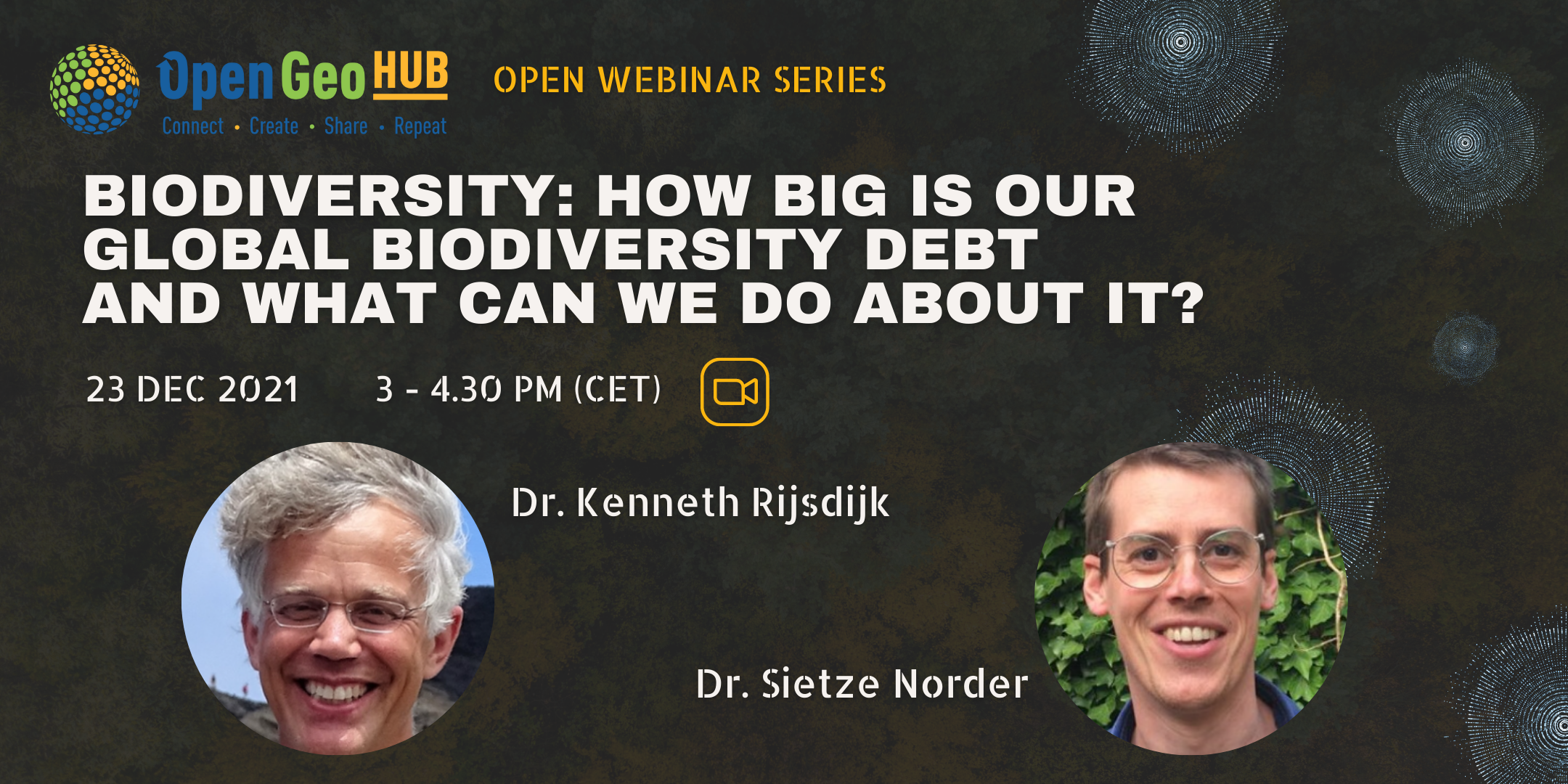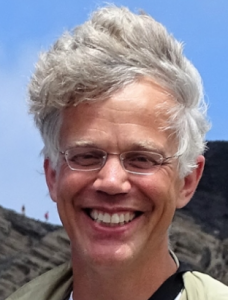
- This event has passed.
Biodiversity: how big is our global biodiversity debt and what can we do about it?

OpenGeoHub Science seminar series 2021
According to climate-expert prof. Johan Rockström, human-induced critical loss of biodiversity on land and in oceans is one of the biggest modern-time risks of leading to global ecosystem instability. Loss of biodiversity, especially in the Tropics, is one of the 9 tipping points of irreversible climate change and life quality degradation on our planet. We have only a few decades to reverse the negative trends and start valuing biodiversity realistically. i.e. using financial damages and risks also affecting the next generations. But how to measure biodiversity and what is our global biodiversity debt? How much can we learn from the further and closer past? Two biodiversity scientists from the University of Amsterdam and Leiden join us to discuss their discoveries with modelling species dynamics through time using historic data and biogeography.
Registration via Eventbrite.
Programme:
15:00–15:20: Introduction to the topic/questionnaire: “what is our (human) global biodiversity debt?”
15:20–15:50: “Biodiversity: some lessons from the last 100k years” by Dr. Kenneth Rijsdijk, Universiteit van Amsterdam
It is long known that the present-day distribution of species (biodiversity) is shaped by geological forces such as mountain formation and drifting of the continents that separated species over millions of years. Also it is well known that present day distributions of plants and animals, including us, are the effect of more recent migrations, be it active (humans) or randomly (seeds). Only recently, we discovered that sea level fluctuations forced by natural climatic change cycles acting over 100,000 yrs played a major part in the distribution of organisms across our planet. This research contributes to our understanding of how much change species naturally endured – if we know the baseline rate of natural change, we can compare it with rates of change induced by humans; and evaluate whether the present-time biota would be able to keep up.
Kenneth is assistant professor at the BIOMAC Research Group of IBED University of Amsterdam. His research is focused on the dynamics of abiotic processes that shape the earth’s surface and affect biota. He is especially interested in how environmental processes affect landscapes and ecosystems.
Recent publications:
Rijsdijk, K.F., Hengl, T., Norder, S.J., Otto, R., Emerson, B.C., Ávila, S.P., López, H., van Loon, E.E., Tjørve, E. and Fernández‐Palacios, J.M., (2014). Quantifying surface‐area changes of volcanic islands driven by Pleistocene sea‐level cycles: Biogeographical implications for the Macaronesian archipelagos. Journal of Biogeography, 41(7), pp.1242-1254.
Fernández‐Palacios, J.M., Rijsdijk, K.F., Norder, S.J., Otto, R., de Nascimento, L., Fernández‐Lugo, S., Tjørve, E. and Whittaker, R.J., (2016). Towards a glacial‐sensitive model of island biogeography. Global Ecology and Biogeography, 25(7), pp.817-830.
Rijsdijk, K.F., Buijs, S., Quartau, R., Aguilée, R., Norder, S.J., Ávila, S.P., De Medeiros, S.M.T., Nunes, J.C.C., Elias, R.B., Melo, C.S. and Stocchi, P., (2020). Recent geospatial dynamics of Terceira (Azores, Portugal) and the theoretical implications for the biogeography of active volcanic islands. Frontiers of Biogeography.
15:50–16:20: “Global hotspots of biological and cultural diversity: exploring the parallels between biogeography & geolinguistics” by Dr. Sietze Norder, Universiteit Leiden
Planet Earth houses a fascinating and abundant diversity in terms of plant- and animal species, as well as in human cultures. Surprisingly, hotspots of biological and cultural diversity are often found in similar locations. A better understanding of the environmental and societal drivers underlying these patterns is urgent because global biocultural diversity is severely threatened. Species are currently going extinct at rates which largely exceed long-term background rates. The same is true for cultures: the global variation in languages for example, one aspect of cultural diversity, is declining rapidly as well. In this talk, SIetze will discuss the spatial distribution of bio- and cultural diversity, their drivers, and how an integrated perspective could provide opportunities for their conservation.
Sietze studies how patterns of biological and cultural diversity have been shaped by interactions between climate, topography, and ecology. While he has a background in biogeography, he is now a postdoctoral researcher at the Leiden University Centre for Linguistics where he applies methods and theories from biogeography to patterns of human cultural diversity and migration. He has recently published a book on island biodiversity called: “The World in Miniature” (currently only available in Dutch; an English summary is available here).
Recent publications:
Norder, S.J. (2021) De wereld in het klein: wat eilanden ons vertellen over de relatie tussen mens en natuur. https://sietzenorder.nl/en/island-book/
Norder, S.J. et al. (2021). Global change in microcosms: environmental and societal predictors of land cover change on the Atlantic Ocean Islands. Anthropocene, 30, 100242 https://doi.org/10.1016/j.ancene.2020.100242
Norder S.J. et al. (2019). Beyond the Last Glacial Maximum: island endemism is best explained by long-lasting archipelago configurations. Global Ecology and Biogeography. https://doi.org/10.1111/geb.12835
16:20–16:30: Summary discussion and closing points
Discussion topics:
- What are the state-of-the-art biodiversity indices? And which are actually used in decision making / ecosystem accounting?
- What is our global biodiversity debt (since pre-industrial time)?
- How much do international initiatives such as GBIF and ESA EO missions help tackle the problems of biodiversity loss?
- How important is biodiversity in the time of COVID-19 pandemic (and does it have anything to do with the pandemic)?
- What can we learn from the past? Which are currently the best models of biodiversity preservation / regeneration?
- How will global climate change / global warming affect biodiversity and how much should we worry?
References:
- Skidmore, A. K., Coops, N. C., Neinavaz, E., Ali, A., Schaepman, M. E., Paganini, M., … & Wingate, V. (2021). Priority list of biodiversity metrics to observe from space. Nature ecology & evolution, 5(7), 896-906. https://doi.org/10.1038/s41559-021-01451-x
- Perry P. (2019). Easter Island Shows Why Humanity Will Be Extinct Within 100 Years. BigThink.com.
- Larry J. Gorenflo, et al., (2012). Co-occurrence of Linguistic and Biological Diversity in Biodiversity Hotspots and High Biodiversity Wilderness Areas. Proceedings of the National Academy of Science 109, no. 21: 8032-8037. https://doi.org/10.103/pnas.1117511109
- Lenton, T. M., Rockström, J., Gaffney, O., Rahmstorf, S., Richardson, K., Steffen, W., & Schellnhuber, H. J. (2019). Climate tipping points—too risky to bet against. Nature, https://doi.org/10.1038/d41586-019-03595-0
- Turner, W., Rondinini, C., Pettorelli, N., Mora, B., Leidner, A. K., Szantoi, Z., … & Koh, L. P. (2015). Free and open-access satellite data are key to biodiversity conservation. Biological Conservation, 182, 173-176. https://doi.org/10.1016/j.biocon.2014.11.048


